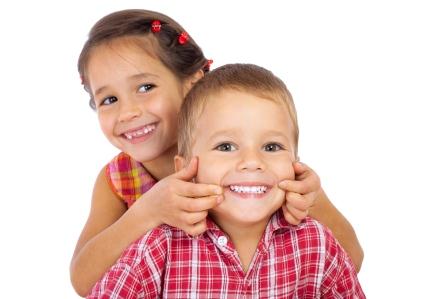From the time your babies are born, people are dolling out dental health advice – what the should and shouldn’t eat and drink, pacifiers or no, to have a bottle at night or not…the advice doesn’t stop. As annoying as it may be, though, the road to good dental health does start young, and it’s best to set out on the right path. Maybe the debate on the pacifier or not will go on and on, but there are some good guidelines to go by regarding your kids’ dental health.
Babies and Toddlers
It’s not too early to begin setting the stage for great dental health for kids from an early age. It’s important to keep the gums of babies clean, even before teeth come in, and this is as easy as wiping little gums with a moist gauze or soft cloth. Once teeth start coming in, as early as four to six months, do the same with wiping the teeth with a soft cloth. You can also start using a very soft baby toothbrush this early.
It’s also important to go ahead and find a dental practice that focuses on family dentistry, even before you may need one. It’s not unheard for toddlers to have an early need to visit the dentist, whether because of an accident or dental issues. If you already have a dentist you like, you don’t need to worry about finding one in an emergency.
As for toddler dental hygiene, this is the time to start guiding them to brush and floss regularly. You can help them brush their teeth twice a day with a very small amount of toothpaste. Many parents prefer the toddler toothpastes; the taste isn’t so strong. Remember to teach good habits:
- Use just a pea size amount of toothpaste for kids 3 years and up, and about the size of a grain of rice for those younger.
- Teach them to spit out the toothpaste, not to swallow it.
- When teeth touch, it’s time to start flossing. You can do it for your child, but let them start getting the feel of it.
- Use a child size toothbrush. Not only does it fit in a young child’s mouth and reach teeth better, but it’s also good for little hands.
- Always supervise at this age.
School Age Kids
By the time kids reach school age, they should be visiting the dentist on a regular six month basis. This sets the stage for regular checkups and can get them used to the procedures at the dentist, including the equipment and routine. The ADA recommends the first dental visit to be around their first birthday. Here are some routine things a pediatric dentist may do at a child’s visit:
- Fluoride treatments to help prevent decay and cavities.
- X rays to look for any abnormalities and make sure teeth are on track to come in.
- They can refer you and your child to any other dental expert if needed.
- Recommend an orthodontist when it’s time for braces.
Image Source: http://www.opa.ca.gov/PublishingImages/KidsSmile_sml.jpg
The things you can do at home are remind your children to brush and floss their teeth and help instill good habits. That’s something moms will always be doing. Though flossing isn’t something most kids want to do, it’s a good idea to make it a habit. As for brushing, you may still want to monitor every so often to make sure kids are doing a thorough job. A quick few seconds of a toothbrush in the mouth won’t necessarily get the job done.
If your child complains of tooth or gum pain, take notice. It may be something as simple as food caught in a tooth, but if it lasts more than a couple of days, you may want to take your child to the dentist. The pain or discomfort may indicate an issue that might need attention.
A Life of Good Habits
By instilling good dental routines at home and regular visits to the dentist, you’re on the right track to keep your children’s mouths healthy. Habits are hard to break, even the good ones, so if your children are used to taking good care for their mouths, it should continue all their lives. That includes good brushing, flossing and regular dental check ups. If you need inspiration every now and then, take them to pick out a new toothbrush – who doesn’t love that?

